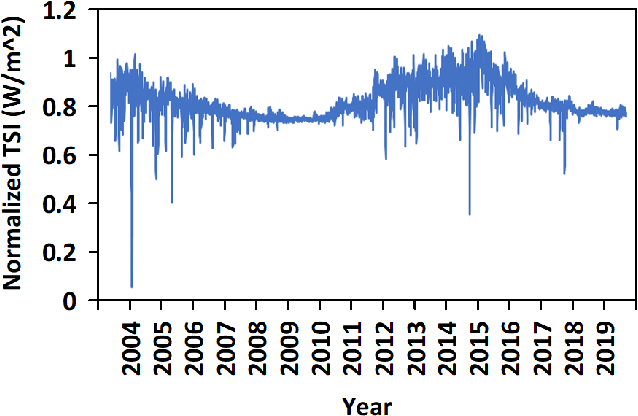Serena Criscuoli
Reconstruction of Solar EUV Irradiance Using CaII K Images and SOHO/SEM Data with Bayesian Deep Learning and Uncertainty Quantification
Aug 09, 2025Abstract:Solar extreme ultraviolet (EUV) irradiance plays a crucial role in heating the Earth's ionosphere, thermosphere, and mesosphere, affecting atmospheric dynamics over varying time scales. Although significant effort has been spent studying short-term EUV variations from solar transient events, there is little work to explore the long-term evolution of the EUV flux over multiple solar cycles. Continuous EUV flux measurements have only been available since 1995, leaving significant gaps in earlier data. In this study, we propose a Bayesian deep learning model, named SEMNet, to fill the gaps. We validate our approach by applying SEMNet to construct SOHO/SEM EUV flux measurements in the period between 1998 and 2014 using CaII K images from the Precision Solar Photometric Telescope. We then extend SEMNet through transfer learning to reconstruct solar EUV irradiance in the period between 1950 and 1960 using CaII K images from the Kodaikanal Solar Observatory. Experimental results show that SEMNet provides reliable predictions along with uncertainty bounds, demonstrating the feasibility of CaII K images as a robust proxy for long-term EUV fluxes. These findings contribute to a better understanding of solar influences on Earth's climate over extended periods.
Deep Learning Based Reconstruction of Total Solar Irradiance
Jul 23, 2021



Abstract:The Earth's primary source of energy is the radiant energy generated by the Sun, which is referred to as solar irradiance, or total solar irradiance (TSI) when all of the radiation is measured. A minor change in the solar irradiance can have a significant impact on the Earth's climate and atmosphere. As a result, studying and measuring solar irradiance is crucial in understanding climate changes and solar variability. Several methods have been developed to reconstruct total solar irradiance for long and short periods of time; however, they are physics-based and rely on the availability of data, which does not go beyond 9,000 years. In this paper we propose a new method, called TSInet, to reconstruct total solar irradiance by deep learning for short and long periods of time that span beyond the physical models' data availability. On the data that are available, our method agrees well with the state-of-the-art physics-based reconstruction models. To our knowledge, this is the first time that deep learning has been used to reconstruct total solar irradiance for more than 9,000 years.
 Add to Chrome
Add to Chrome Add to Firefox
Add to Firefox Add to Edge
Add to Edge